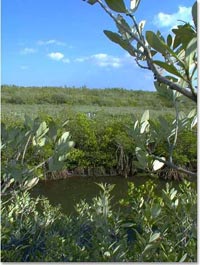Changing Characteristics of Mangrove Systems in South Florida

The purpose of this study is to examine the effects of nutrient availability on growth, nutrient cycling, and decomposition in a mangrove system that has been severely impacted by anthropogenic disturbance. Our study site is in an abandoned mosquito impoundment along the lagoonal side of Indian River Lagoon.
Two types of disturbance regimes have been imposed on the study site; specifically, alteration of the hydrology in the construction of the impoundment and enrichment (eutrophication) from coastal runoff. We asked, "How do these two major types of anthropogenic disturbances couple to impinge on ecological processes in mangrove ecosystems?" Our objectives are to determine if disturbance affects patterns of nutrient dynamics in mangrove forests.
Results from this experiment will be compared with similar studies in pristine mangrove forests to determine if disturbance affects patterns of nutrient dynamics in these coastal ecosystems. In temperate salt marshes, ecological processes such as primary production and decomposition have been shown experimentally to be nitrogen (N) limited.
The few tropical and subtropical mangrove wetlands that have been studied appear to be primarily phosphorus (P) limited. However, data are lacking on what types of changes might be expected to occur in mangrove ecosystems in response to anthropogenic disturbances, including dredging, diking, and clearing, coupled with the ongoing process of eutrophication of the coastal zone, which is often immediately next to oligotrophic, but highly diverse, marine ecosystems.
Our results show that the mangrove forest at the mosquito impoundment is N limited. Nitrogen enrichment caused dramatic changes in plant growth, carbon gain, tissue quality, herbivory, and nutrient conservation patterns. These findings contrast sharply with our experiments in Belize and Panama where the mangrove forests have complex nutrient gradients.

